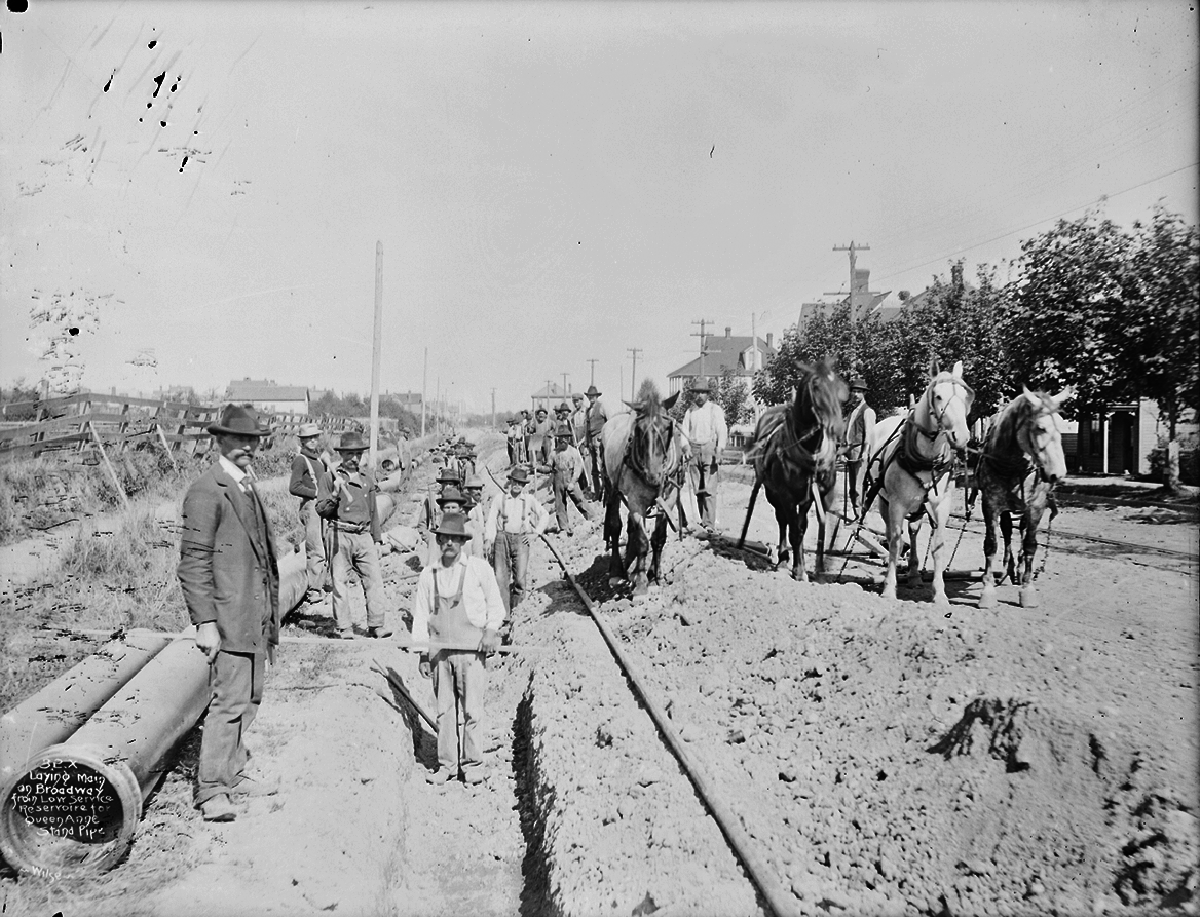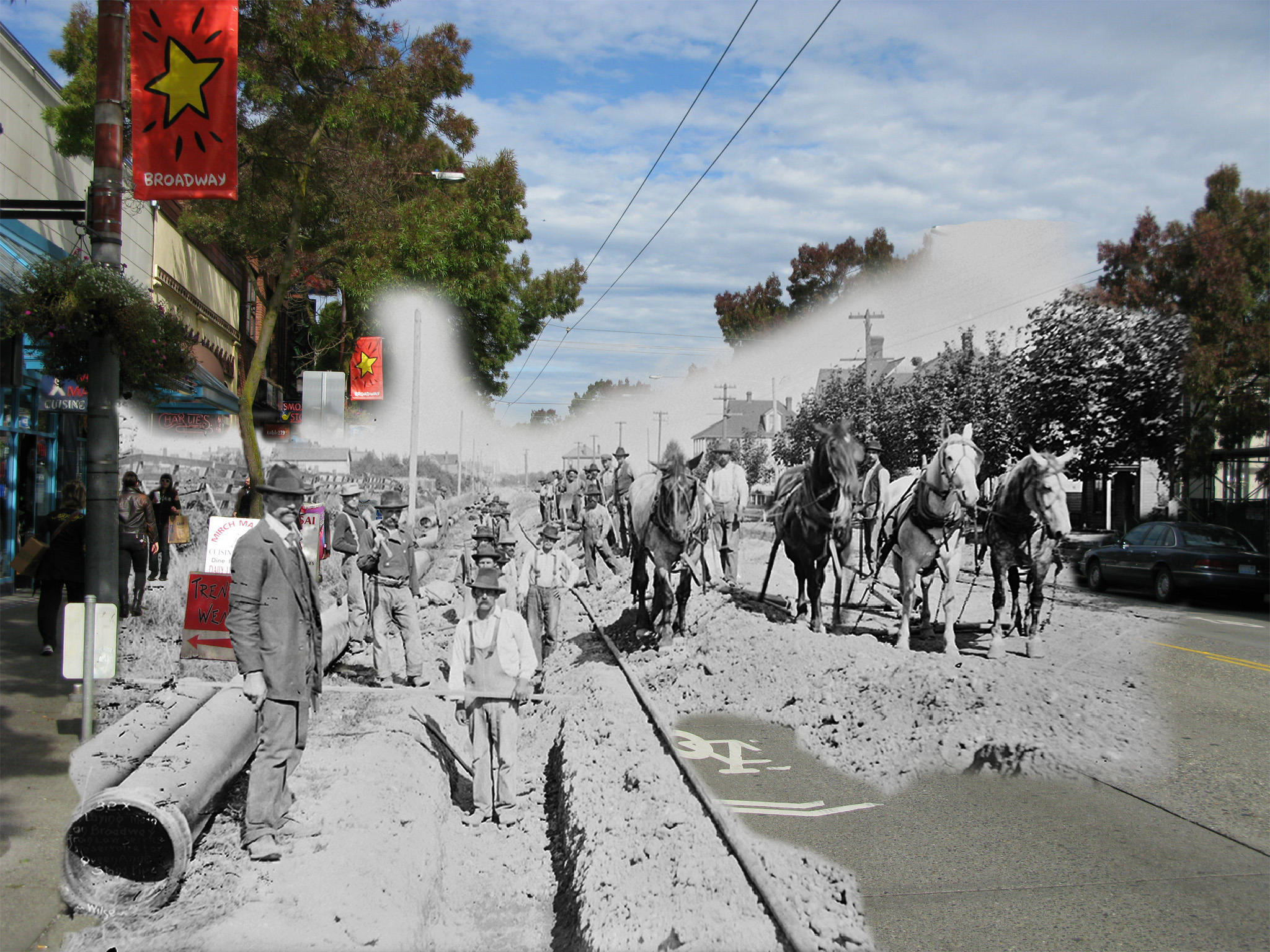You know Teriyaki & Wok? You probably remember it as the Baskin Robbins that was there for 30 years. That’s where the Johnson home was back in 1899. In this photograph it’s off in the distance. It looks like it’s in the middle of Broadway because the road narrowed. We’re standing at Olive/John, looking north on Broadway East, right next to Rite-Aid.
During the month of January my father died… During the summer, I used to sit with papa on the front porch and watch the stars as they came out, one by one… His favorite planet was Mars, shining with its fiery red light. For hours he would sit and talk about Mars. He would tell me stories of what the people might be like, how they might live and what they might be doing at that minute. He would often say, ‘Son, when I am dead I believe I will go to Mars… I believe we will all meet there some day. We will be greater and stronger there.’… Now when I look at Mars I wonder if papa is there, looking down at me in the evening… I will always be a good boy so when he looks at me he will see that I am doing my best on this old earth. (4 Mar 1906 Seattle Times)
Walter Johnson was an eighth grader at Pacific School when he wrote this amazing, 2nd-prize winning essay about the death of his father Joseph H. Johnson. Joseph died at their family home at 322 North Broadway in January, 1906. Hey wait, put down that bike helmet! Don’t run off to Twice Sold Tales looking for the works of Seattle’s first science-fiction author.
Johnson had a totally unique view of Mars, but unfortunately he was an unlettered capitalist. When this photograph was taken, the Johnsons were new to the neighborhood, arriving in 1898 from Montana. Like the Glasgows they had money – Johnson was president of Montana Savings and Loan, president of several mining companies, and had property all over the place. These were the capitalists that some of Occupy Seattle Central are protesting, right? Not exactly.
The Johnsons were Seattle-style capitalists. Remember how Sam Archer made his money in the goldfields of Alaska? Joseph Johnson worked even harder, first in coal mines in Pennsylvania and then as a butcher in Oakland and Portland. He began cattle ranching near Walla Walla and moved to Great Falls, Montana where he found his riches before retiring to Seattle. So he probably felt camaraderie with the day laborers pictured here, working for Pacific Bridge Company to build the Cedar River Pipeline. It went from the watershed all the way to Seattle and new reservoirs at Beacon Hill and Capitol Hill. A short section required digging up two blocks of Broadway’s dirt road.
 (Image: Seattle Municipal Archives)
(Image: Seattle Municipal Archives)
As you can see, there were still many farm parcels and unimproved lots out here in 1899. Broadway was becoming an extension from Madison of First Hill’s mansions. But the upper class homes were mixed in together with shacks and huge, working-class families. Where Johnson built his house at Broadway and Harrison, there had been a group of blue-collar families for at least a decade: a couple of laborers, a logger, a teamster, a housemover — even a Lake View Cemetery gravedigger are in the 1888 city directory. There was a similar group a block behind us at Denny, perhaps sharing a boarding house.
At the time of our photo, a massive mining family named McNamee lived on the far right. Beyond them William Bolt, a carpenter, and then the Fir Land Meat Market and grocery. The house on the left beyond the fence, where Chase is now, was the home of Raymond Hodgdon, the bookkeeper for John Collins. These ditch diggers came and went, forgotten by history. There’s no trail of that 1888 gravedigger — technically a sexton — William Metts, either. He certainly didn’t warrant a grave at the Masonic cemetery where he labored. Neither did any of the Irish miner McNamees. You know who did? Sure, Bruce Lee. But also, Iowan Samuel Glasgow and family. Fir Land butcher Christian Weber. Collins bookkeeper Raymond Hodgdon. And while Joseph Johnson’s spirit may be now Superman-like on Mars, he remains at Lake View.
Local history expert Rob Ketcherside shares his vision of the past and present with his Re:Take series of works on CHS and other Seattle sites.




just wanted to let you folks know there are people out there who appreciate your photoshop efforts. I love learning about the history of this place I call home.
The “mixed” photo of modern-day and 1899-era Capitol Hill was pretty cool, but I got a terrific jolt when seeing the full 1899 image. It looks like it was taken out on a prairie somewhere! Amazing to think about what was happening on that spot 100+ years ago while I’m breakfasting at Table 219.
Thanks so much for this post. Looking forward to reading more of them!
I love the old photo, both in its original form and the mixed image. Great article, thank you for this!
Have you seen the art work now covering some of the electrical boxes along Broadway? I think they are a great addition to the streetscape, but at one time I advocated for the boxes to be covered with historical photographs of the neighborhood (using printed latex), such as in this post…..I think that would have been an even better use of the boxes, reminding all passers-by what was there in the past.
I am a big Seattle history nerd, so I’m loving this series. In all my years of scouring the internet for old photos of Cap Hill, I have never seen this one of Broadway. Very cool!
nifty. One does wish that folks weren’t so devoted to hats at the time — hard to see faces.
Such fun, Rob. Keep it up!
Thanks so much for these photos and articles about the history of the neighborhood. I really get excited when I see another one is up. Thanks again!
Great idea, and it’s never too late. The paint will wear off or be tagged eventually.
FWIW, I love the paint. I tried advocating for this after a trip to San Diego a number of years ago. Did it work??
Thank you!
Thanks, I spent way too much time in Photoshop on this one :) I’m getting skills though.
Appreciate it!
That’s a great compliment — I love digging for buried treasures. If you click through the “Cedar River Pipeline” link you’ll see that Paul Dorpat wasn’t quite sure where this was taken.
You’re right — even the bigger version covers their eyes. Reminds me of Toby Keith on Colbert Report.
BTW, don’t those street trees look like fruit trees?
More to come :)
I’m glad you like my idea, Robert, but I’m afraid the current art on the boxes is designed to have some staying-power. I was told by one of the installation artists that it is covered in some kind of protective coating which makes it easy to clean off graffiti. And so far the jerks who tag everything have kept their dirty hands off these boxes, with only an occasional exception.
super interesting history and cool images – very unique – thank you so much! (-cap hill neighbor)